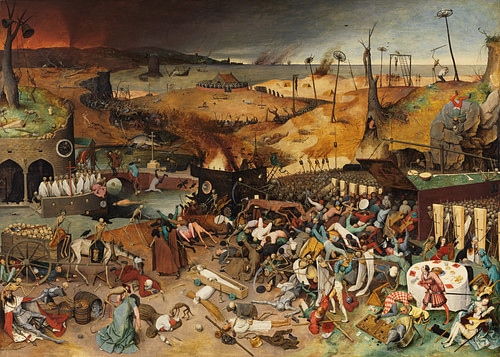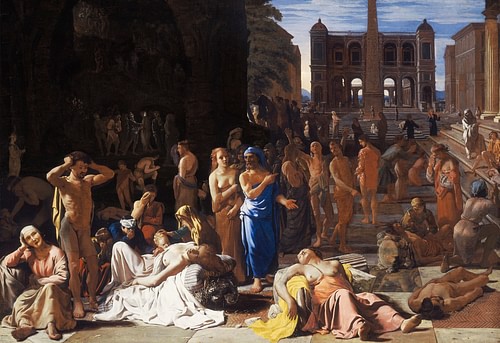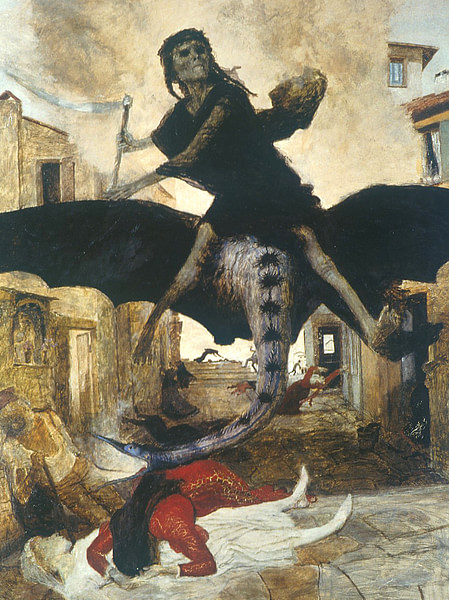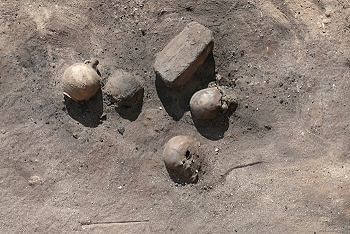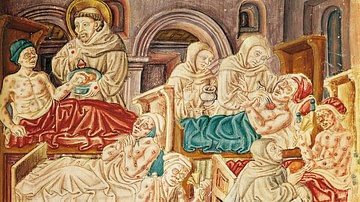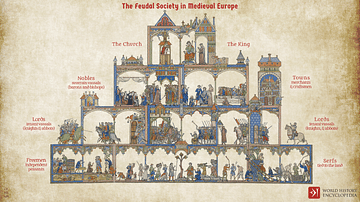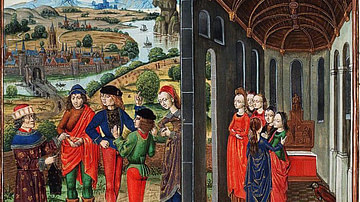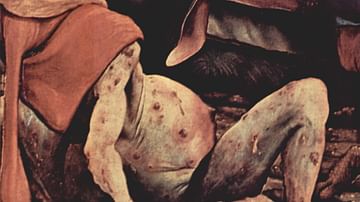The word 'plague', in defining a lethal epidemic, was coined by the physician Galen (l. 130-210 CE) who lived through the Antonine Plague (165 - c. 180/190 CE) but the disease was recorded long before in relating the affliction of the Plague of Athens (429-426 BCE) which killed many of the city's inhabitants, including the statesman Pericles (l. 495-429 BCE). This epidemic, and some of the others that followed, may or may not have been actual plague as it was later defined; ancient writers tended to use the term plague for any widespread outbreak of pestilence.
Plagues certainly may have existed prior to the Athenian outbreak – and almost certainly did – but most studies of the epidemic begin with Athens as it is the first recorded by an eyewitness and survivor, the historian Thucydides (l. 460/455 - 399/398 BCE). Plagues are routinely named either for the person who reported them, the monarch at the time of the outbreak, the region afflicted, or by an epithet as in the case of the Black Death.
The major recorded plagues of the ancient and medieval world are:
- Plague of Athens
- Antonine Plague
- Plague of Cyprian
- Plague of Justinian
- Roman Plague
- Near East Plagues
- Black Death
- Columbian Exchange Epidemics
Of these, the Columbian Exchange Epidemics are not considered plague as they were a sweeping contagion of smallpox and other diseases but were just as lethal to the indigenous people of the Americas as plague was elsewhere. Other epidemics not considered plagues but which still ravaged populations were leprosy – especially during the 11th century CE in Europe – and the Japanese smallpox epidemic of 735-737 CE. Epidemics and pandemics continued into the modern era and, among the deadliest, were the 1918-1919 CE Spanish Flu epidemic and the HIV/AIDS epidemic (1981-present) though there were many others. At the time of this writing, the Covid-19/coronavirus is proving itself the latest addition to the list of most lethal pandemics in world history.
Nature & Types of Plague
The cause of the plague was unknown until the 19th century CE when the bacterium Yersinia pestis was isolated and identified in 1894 CE. Prior to that time, plague was thought to be supernatural in origin, a punishment from the gods or God, and/or the result of a population's sin. The actual cause was Yersinia pestis which was carried in the fleas of rodents, most often rats, which transmitted the bacterium to humans through bites. Other animals could catch the plague by eating rats – or other rodents – which were infected and this would lead to an epizootic outbreak which then spread to human beings. People die of the plague because of the toxic nature of Yersinia pestis which compromises one's immune system while, at the same time, multiplying in the body. Since the compromised immune system can no longer fight against the toxins, the person dies.
Plague is always described as beginning with symptoms resembling the flu, which appear, usually, 3-7 days after one has become infected. The symptoms at first are chills, body aches, fever, and overall weakness, which then progresses to vomiting, diarrhea, dehydration, respiratory failure (in some cases), and death. The three types of plague are:
- Bubonic: caused by the bite of a carrier flea. This plague attacks the lymph nodes, inflaming them, and the swollen nodes are then called buboes, hence the name.
- Septicemic: caused by either an infected flea or contact with an infected animal. It attacks by entering the bloodstream and multiplying.
- Pneumonic: caused by contact with an infected animal and spreads person-to-person through coughing. It attacks the lungs, rapidly multiplying, which triggers an immuno-response eventually shutting the lungs down and leaving the person to die of respiratory failure.
Of the following, the first three may or may not have been plague. Descriptions of them by eyewitnesses suggest they may have been typhus or smallpox outbreaks but could have been plague.
Plague of Athens (429-426 BCE)
The Plague of Athens (death toll: 75,000-100,000) arrived through the port of Piraeus, probably in 430 BCE, and erupted across the city in 429 BCE. Thucydides writes:
It is said to have broken out previously in many other places, in the region of Lemnos and elsewhere, but there was no previous record of so great a pestilence and destruction of human life. The doctors were unable to cope, since they were treating the disease for the first time and in ignorance; indeed, the more they came into contact with sufferers, the more liable they were to lose their own lives. (III.81; Grant, 77)
Athens had been engaged in the Second Peloponnesian War (431-404 BCE) against Sparta, and the general and statesman Pericles had recently ordered a retreat behind Athens' walls. The close quarters of the now-inflated population meant that, once the plague entered the city, there was no room for quarantine of the sick; the disease therefore spread quickly.
The symptoms included a fever, sneezing, sore throat, extremely bad breath, violent coughing, chest pains, insomnia, and convulsions. Many people were in good health when the plague struck but succumbed within ten days after the first symptom of the fever. This fever persisted throughout at such a degree that people could not tolerate clothing and were constantly in need of water which they could not hold down. Those who tried to help died so quickly that others began abandoning the ill and looking after their own interests. Thucydides describes a complete breakdown of law and abandonment of religious practices:
No one was willing to persevere in struggling for what was considered an honorable result since he could not be sure that he would not perish before he achieved it. What was pleasant in the short term, and what was in any way conducive to that, came to be accepted as honorable and useful. No fear of the gods or law of men had any restraining power, since it was judged to make no difference whether one was pious or not as all alike could be seen dying. No one expected to live long enough to have to pay the penalty for his misdeeds; people tended much more to think that a sentence already decided was hanging over them and that, before it was executed, they might reasonably get some enjoyment out of life. (III.83; Grant, 79)
Even so, those who survived the disease – and found they were now immune – devoted themselves to helping others still afflicted. The plague killed many of the most prominent citizens, Pericles among them, and affected the outcome of the war. With so many dead, and the city significantly weakened, Athens struggled to maintain the war effort and eventually lost to Sparta.
Antonine Plague (165 - c. 180/190 CE)
The Antonine Plague (death toll: 5 million) devastated the Roman Empire under the co-rule of Marcus Aurelius (r. 161-180 CE) and Lucius Verus (r. 161-169 CE) and is so-called after Aurelius' family name, Antoninus. It first appeared in the Roman army during the siege of the city of Seleucia in the winter of 165-166 CE and was spread by these troops returning to Rome or as they were stationed elsewhere.
Symptoms, as described by Galen, began with fever and included diarrhea, outbreaks on the skin, pharyngitis (the inability to swallow) accompanying a sore and swollen throat, unbearable thirst, coughing, and vomiting. Those who caught the disease either died or recovered within two weeks. The plague is thought by modern scholars to have originated in China and spread westward along the Silk Road as the cities of Ctesiphon and Seleucia were important trade links with direct access to Chinese suppliers. People of the time, however, interpreted the epidemic as a punishment for sin with various stories circulating assigning blame.
According to the historian Cassius Dio (l. c. 155 - c. 235 CE), the disease killed upwards of 2,000 people a day and took both Lucius Verus (in 169 CE) and Aurelius (in 180 CE). Aurelius had blamed the Christians for the plague, claiming they had angered the gods by refusing to participate in the state religion, and persecuted them. The Christians, however, became the primary caregivers at this time, nursing the afflicted without regard for their own safety; as a result, more people converted to Christianity.
The Antonine Plague has routinely been cited as the beginning of the destabilization of the Roman Empire. Whether one accepts this claim, it cannot be argued that the plague completely changed the dynamics of Roman society. The army was weakened by the immense loss of troops and new recruits from among Germanic tribes did not have the same level of loyalty. Gladiators died as easily as anyone else and there were fewer games, resulting in public unrest which, coupled with the peoples' abandonment of traditional religious practices in favor of Christianity, broke social cohesion. Farmers were unable to produce crops, artisans were no longer alive to make crafts, and so many people died that the economy came close to failing.
Plague of Cyprian (250-266 CE)
The Plague of Cyprian (death toll: 5,000 people a day) takes its name from St. Cyprian (d. 258 CE), the cleric who recorded it. Unlike Galen, Cyprian was not a doctor but still presents a vivid image of the progress of the disease and its effects. The first symptom, as with the earlier epidemics, was fever which was followed by general weakness/fatigue, sore and swollen throat, hearing loss, diarrhea, vomiting, and possibly eye infection. Modern-day scholars have suggested the epidemic may have been bubonic plague, cholera, or typhus but could also have been smallpox.
This outbreak is also thought to have originated in China and traveled along the Silk Road to Alexandria and then on to Rome. It struck at a time when the Roman Empire was already weakened, during the Crisis of the Third Century (235-284 CE), when there was no strong central leadership and 'barracks emperors' rose to power on the strength of their ties to the military and fell quickly when they could not deliver on their promises. Record keeping at this time was, therefore, poorly maintained generally, and there is no official death toll for the plague outside of the generally accepted number of 5,000 people a day, derived from scattered reports of the time and that of Cyprian.
As with the Antonine Plague, Christians became the central caregivers which strengthened the religion further. The emperors Hostilian (r. 251 CE) and Claudius Gothicus (r. 268-270 CE) both died as well as many of the pagan clergy which left predominantly Christian clerics to explain the cause of the disease in Christian terms. The plague further weakened the Roman army and economy as more soldiers were lost than in the Antonine plague and the deaths of farmers left crops to rot in the fields.
Plague of Justinian (541-542 CE & onwards)
Although the dates of the Plague of Justinian (death toll: 50 million) are routinely given as 541-542 CE, considered the worst phase, the epidemic continued long afterwards, finally vanishing c. 750 CE. It is the first fully documented case of the plague, as caused by the bacterium Yersinia pestis, in the world. The plague takes its name from the monarch of the Byzantine Empire, Justinian I (r. 527-565 CE) and was first recorded by the historian Procopius (l. 500-565 CE) who chronicled many of the events of Justinian I's reign.
This plague, considered the most devastating up to that time, is also thought to have originated in China and traveled to India via the Silk Route and then on to the West. Constantinople, the capital of the Byzantine Empire, was another city – like Seleucia and Ctesiphon – which served as a major trade center and conduit between the east and west. Procopius reports unusually cold weather which blighted crops and drove people from rural regions toward cities like Constantinople seeking shelter and assistance; with these people came the rats, who found shelter in carts of supplies.

People first experienced fever and fatigue before swellings of buboes broke out around their ears, in their armpits and groin. Procopius reports people becoming delusional before falling into comas and dying within a week of contracting the infection. The cause of the plague, according to Procopius, was Justinian I's misguided reign which God was now punishing him and his people for. Justinian I did fall ill but recovered while many others did not.
Modern-day scholars believe that, along with transmission along the Silk Road, the plague was spread by the supply trains of Justinian I's army which carried infected rats back to Constantinople. The people of the time, however, had no idea of the cause and so no concept of how to treat the plague, relying mainly on prayers and protective amulets. The only effective action which slowed the spread of the disease was quarantine of the sick and what is known today as social distancing. The empire survived the plague but in a greatly diminished form having lost approximately 25% of its population.
Roman Plague (590 CE)
The Roman Plague (no statistics on death toll available) was a continuation of the Plague of Justinian but localized at Rome. Like Justinian's plague, it seems to have been a combination of bubonic, septicemic, and pneumonic plague with the bubonic strain most prevalent.
This epidemic was also interpreted as a punishment from God and the pope Gregory the Great (l. 540-604 CE) decreed it could only be stopped by penitential processions through the city, begging for mercy through the intercession of the Virgin Mary. These processions brought a significant number of people in contact regularly, spreading the infection, and reports of the time describe people collapsing and dying as they participated. Even so, the processions continued and, when the plague ended, they seem to have been credited with appeasing God's wrath.
Near East Plagues (562-749 CE)
The plagues of the Near East are usually summarized in discussions of the Plague of Sheroe (627-628 CE) which killed the Sassanian monarch Kavad II (r. 628 CE) whose birth name was Sheroe. The plague had been present in the region over a hundred years earlier, however, and is thought to be a continuation of the Plague of Justinian. When it began in 562 CE, the death toll in the city of Amida was given at 30,000, and the outbreaks of 688-689 CE claimed 200,000 lives in Basra in three days.
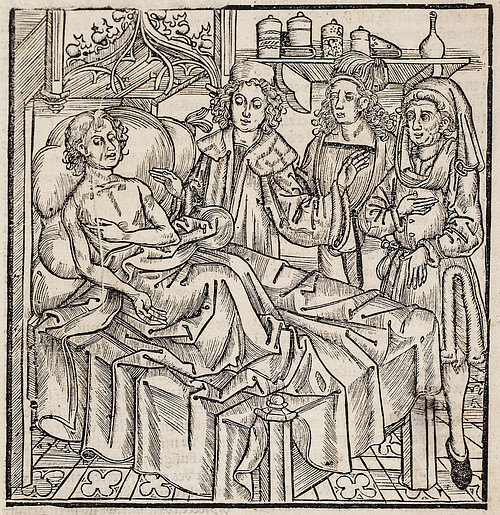
The plague came in phases, some worse than others, and was again attributed to God's anger over humanity's sins. Whatever courses of action people took is unknown because there are so few sources extant. Scholar Peter Christensen comments:
We have very little detailed information of the course of the pandemic [in the region]. Few contemporary accounts have survived. In the 9th century, when the plague had finally disappeared, scholars in Basra wrote brief summaries of the history of the disease. Though considered highly authoritative by later Muslim historians, these “Books of Plague” are in fact incomplete. (81)
It is for this reason that historians usually focus only on the Plague of Sheroe because its effects, at least, are the best documented. Kavad II began his reign by having his brother, stepbrothers, and half-brothers murdered so they could not challenge his claim to the throne. After eliminating every legitimate successor, he reigned only a few months before dying of the plague. The only person left who could succeed him was his seven-year-old son Ardashir III (r. 628-629 CE) who was controlled by a regent and quickly overthrown, setting in motion the instability which contributed to the collapse of the Sassanian Empire.
Black Death (1347-1352 CE)
The Black Death (death toll estimated at 30 million people) is the best-known plague in history, killing between 30-50% of the population of Europe. Although this epidemic has been identified as bubonic plague, the other two types were also present. As with the earlier outbreaks, symptoms began with a fever, body aches, and fatigue before buboes appeared on the body in the groin, armpits, and around the ears; the black buboes gave the plague its name. People usually died within three days of infection.
This plague is also thought to have originated in Asia and arrived in Europe, most likely, through Sicily via Genoese trading ships coming from the east which were infested with rats and their fleas (although historians also cite the Silk Road land routes as a probable source of transmission). The Genoese ships are the most likely source as it is documented that one of these docked in Marseilles and Valencia, spreading the disease to both. Within two years, Britain, France, and Spain were reeling under the plague and trade then carried it further to Ireland. By c. 1350 CE, it had spread to Germany, then Scandinavia, and into Russia.
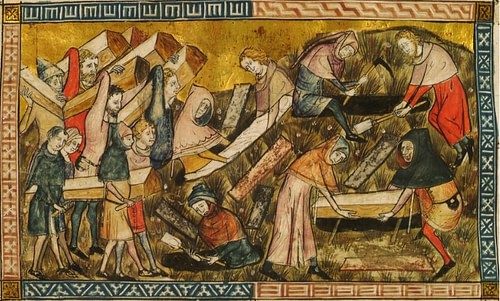
This plague was also attributed to God's wrath, the devil, and the sinfulness of humanity and treatment was centered on religious rites and observances. Certain marginalized groups were also blamed and pogroms against the Jews increased. In the port of Ragusa (modern-day Dubrovnik, Croatia), however, which was controlled by Venice, authorities took another, and far more effective, approach. They instituted a law establishing a 30-day isolation period for ships arriving from areas affected by plague which was known as the trentino (30 days). No one from the port could visit these ships during the thirty days nor could anyone from the ships come ashore. Ragusa had been severely struck by the plague in 1348 CE and seem to have been the first to institute measures to stop its spread.
This practice would eventually be adopted by other cities in different countries who expanded it from ships to towns and cities and extended the period to forty days under the law of quarantino (40 days) which provides the root for the English word quarantine. Anyone breaking quarantine could be fined and were then placed in further isolation but the wealthy could always buy their way out and others simply ignored the policy and so the disease continued to be spread by those who would not abide by the law and remain in seclusion.
The consequences of the epidemic were far-reaching in that it almost completely transformed medieval European society. The feudal system and institution of serfdom – which tied the working poor to the land of the wealthy lord – could no longer be maintained because so many people had died that those who could still work demanded greater autonomy and payment. Women's rights improved since many had lost their land-owning husbands and sons and were allowed to retain control of the properties and businesses. A notable consequence was a shift in focus from God and heaven to humanity and life on earth which would eventually give rise to the Renaissance.
Columbian Exchange (1492-1550 CE)
The Columbian Exchange is the modern-day term for the transference of culture, people, and technology between Europe and the so-called New World following Christopher Columbus' expedition of 1492 CE. The exchange also brought the smallpox epidemic (and other diseases) which killed between 80-90% of the indigenous population of the Americas who had no immunity against European diseases. The epidemics which swept through the populace in 1520 CE and again between 1545-1548 CE emptied towns, villages, and cities and contributed to the fall of the Aztec and Inca Empires.
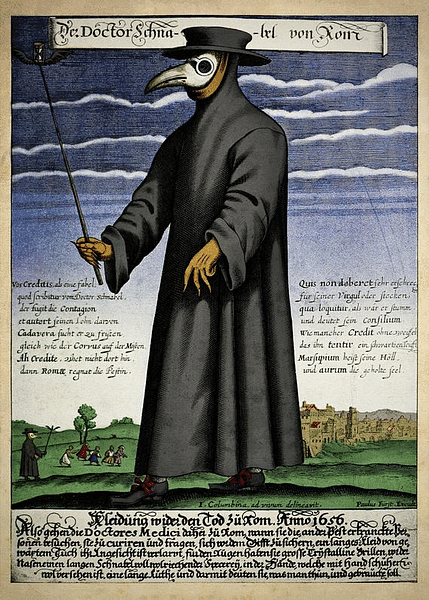
Along with smallpox, the Europeans also brought typhus, the measles, yellow fever and, possibly, syphilis. These diseases, along with military campaigns carried out against the Native Americans by Europeans looking to control land and resources, severely impacted Native American culture. The population of certain tribes and regions was reduced so heavily that colonization was made easier and Europeans came to control the land previously inhabited by the natives.
Conclusion
Plagues continued to destabilize and reduce populations into the modern day. The worst of these was the Influenza Outbreak of 1918 CE also known as the Spanish Flu (so-called because it was first reported by Spain, not because Spain was the source of the pandemic). The death toll is estimated at between 50-100 million worldwide, making it the deadliest plague in world history. Various theories have been proposed as to its source, but it seems to have originated in an army camp in Kansas, USA, and spread from there by troops deploying for WWI who landed in Brest, France. Other epidemics followed throughout the 20th century CE, a notable example being the HIV/AIDS infection which has killed 35 million people since it was first identified in the mid-1980's CE.
These two outbreaks have one underlying characteristic in common: the failure of the population to appreciate the seriousness of the disease until it was too late and the failure of governments to respond to it in a timely fashion. Prior to the recognition of germ theory, it is understandable that people would interpret the plague in terms of the prevailing religious ideology but, in the modern era, the failure of governments and populations to respond quickly with practical measures remains bewildering.
After the Spanish Flu outbreak of 1918 CE, the effectiveness of quarantine was fully recognized. Those cities which enacted lockdowns effectively stopped the spread of the disease. Even so, by the time they acted, more people had been infected and more died while still more helped spread the disease by ignoring the governmental policies on social distancing; a paradigm unfortunately still apparent now with the Covid-19 pandemic.
